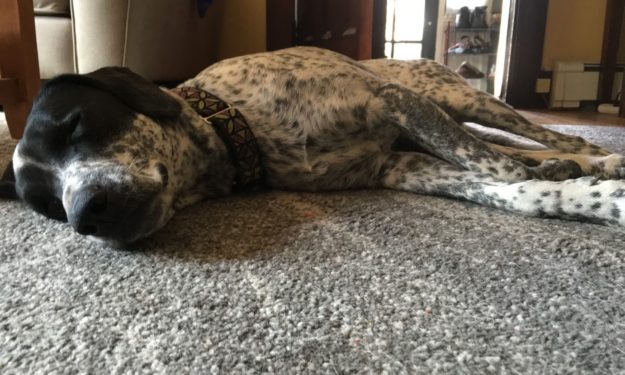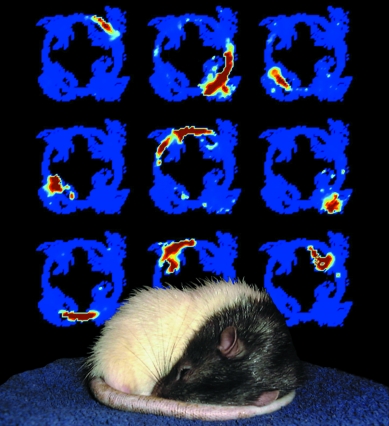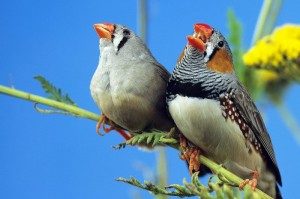Dream a Little Dream: Our Pets Do Dream!

Written by Meagan Dunn,
Emergency and General Practice Technician
One night while laying in bed, I watched my cat, Loofa, twitch her little paws as if she were playing with one of her catnip toys, or pretending she was running away from her dog brother. As I sat there awkwardly staring at her, and of course photographing, I said to myself “I wonder if she is actually dreaming?” This led me to some late night research, because who needs sleep anyways? After some serious reading, and credibility checking, I came to the conclusion that yes, most animals do indeed dream.
What is a Dream?
The definition of the word dream is: “a series of thoughts, images, and sensations occurring in a person’s mind during sleep.” The most vivid dreams occur during the REM (Rapid Eye Movement) stage of sleep. You can actually see the eyes moving, even when the eyelids are shut, in both mammals and birds. During REM sleep, brain activity is very high which is why dreams typically occur during this time. Dreams may occur during other stages of sleep, but they usually are not as vivid. Reptiles and fish do not experience REM cycles, so it is believed that those species do not have dreams.
How Long Have We Wondered About Animals Dreaming?
To my dismay, it turns out that I am not the first person in the world to ever wonder if animals dream. It is actually reported the Aristotle, the Greek philosopher, studied dreams in both humans and animals during the B.C. time period! In his work, “On Sleep and Sleeplessness” he wrote: “It would appear that not only do men dream, but horses also, and dogs, and oxen; aye, and sheep, and goats, and all viviparous quadrupeds (animals who give birth to live young); and dogs show their dreaming by barking in their sleep.” Although his research may be written a bit differently than things we may read now, he was not far off in his thoughts; he was brilliant!
1965: Domestic Animals Dream of Being Wild Again
French scientists Michel Jouvet and J.F. Delorme also did some very interesting research regarding animals and dreaming. They conducted an experiment in which they removed part of a cat’s brainstem (the pons) which prevented the cat from experiencing atony (paralysis during REM sleep). Through this research, they learned that cats would actually sleep walk and show predatory behaviors as if they were hunting. The same type of behavior was also shown in dogs.
2001-2012: Rats & Music, and Birds Practicing Songs in their Sleep
Jumping forward, MIT also conducted research on animals dreaming, but this time using rats. They were able to see the ways the brain reacted while rats were being directed through a maze, and also when they were sleeping. Their brains showed the same patterns of activity during both scenarios!
The image above illustrates the brain activity of the rat during different scenarios. They took it to the next step and played certain sounds/music while the rats made it through different sides of the maze. When the rats were sleeping, they played the sounds associated with the left side of the maze, and then with the right side of the maze. Matthew Wilson of MIT said in an interview, “When the sound associated with the right side was played, the dream content switched to the right side of the maze.”
Biologists at the University of Chicago, Amish Dave and Daniel Margoliash studied the firing patterns of neurons in the zebra finches. Most of us know that birds are not born knowing how to tweet melodies; it is a learned behavior. The biologists noted the electrical brain patterns while the finches sang notes while they were awake. They could tell which notes the finches were singing simply by the way the neurons in the forebrain (robutus archistriatalis) were firing. When the birds were asleep, Dave and Daniel watched the electrical activity in the brain and noticed that the firing of the neurons were very similar as to when they were awake. This proved that the finches were actually practicing their songs while they were sleeping!
Dreaming Cats & Dogs
Unfortunately, not as much research has been done in dogs and cats simply for the fact that it may be a bit more complicated to gather the resources to do the research. Though, scientists do believe that dogs and cats dream about everyday activities. So when your dog softly barks and twitches his/her paws or your cat moves his/her paws as if they are participating in the Catlympics, they are likely dreaming of playing with their toys, eating, or chasing their animal friends. It is definitely comforting to think that your beloved pet may even be thinking of you, and all the fond memories of the day’s events!
Dream on!
More Information:
http://www.bbc.com/future/story/20140425-what-do-animals-dream-about
https://people.com/pets/what-is-your-cat-or-dog-dreaming-about-a-harvard-expert-has-some-answers/

